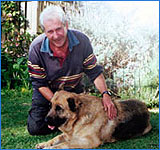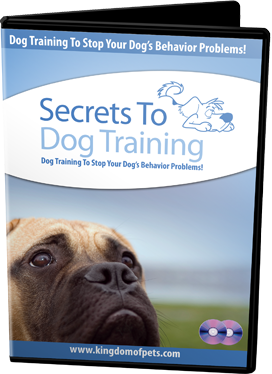If you are looking for the greatest gold-mine of easy to use "change your dog's behavior" advice ever crammed into a newsletter series then read on!
Also, make sure that you check out our 100% authentic testimonials from people who have bought Secrets to Dog Training and find out the massive difference it has made to their owner-dog relationship!
 "Hi Daniel, My dog Holly was not a young girl - we have been together for over 12 years so she was rather past her prime when I purchased Secrets to Dog Training - The Ultimate Guide to raining Your Dog, but I still found it a fascinating read with lots of useful information for both new dog owners and an old lag like myself. The section on dog whispering was especially useful to us as she responded really well to this method. We didn't do much - but we had a lot of fun putting your methods into practice and I learnt heaps.
"Hi Daniel, My dog Holly was not a young girl - we have been together for over 12 years so she was rather past her prime when I purchased Secrets to Dog Training - The Ultimate Guide to raining Your Dog, but I still found it a fascinating read with lots of useful information for both new dog owners and an old lag like myself. The section on dog whispering was especially useful to us as she responded really well to this method. We didn't do much - but we had a lot of fun putting your methods into practice and I learnt heaps.
Sadly Holly has now passed on and at the moment I don't have a dog - but I plan to put your book into practice when I feel ready to share my life with another canine friend. I can honestly recommend your book to anyone contemplating getting a dog. It contains lots of basic advice - essential for the beginner - as well as more advanced material for the experienced dog owner. I have read all sorts of books on dog keeping and training over the 40 odd years I have been keeping German Shepherds but none have been as sensible, useful or comprehensive as Secrets to Dog Training. If you want to use our photo on your website please feel free to do so. All the best."
-- George Barrett (USA)
Grooming is a great opportunity for you and your pet to spend some quality time. Most dogs love being brushed and will often lean into you as they relax and enjoy themselves. Brushing also allows you the opportunity to check your pet for fleas, ticks and any skin irritations.
Grooming is essential for keeping the skin and coat shiny and healthy. Long haired breeds should be brushed daily to prevent tangles and matting, but breeds with short hair only need to be brushed once or twice a week (though this may depend on the amount of hair your dog sheds).
What is shedding? Shedding is the natural hair loss that allows new hair to grow. Only the hairless breeds, such as the American Hairless Terrier and Chinese Crested Hairless variety, do not shed at all. Some breeds shed at a much slower rate and need to be clipped regularly to prevent matting of their coats. Some examples of those that shed less than your average dog are the Bichon Frise, Poodle and Soft Coated Wheaton Terrier.
Most dogs shed their coats once a year, whereas some will actually shed all year round. Indoor dogs in particular are more prone to shed throughout the year, because they are not exposed to the changes in temperature and light during the different seasons as outdoor dogs are.
Long haired breeds can appear to shed more, but this is not usually the case, however the long hair is more noticeable on your clothing and furniture!
Dogs that shed a lot should be groomed three or four times a week. This will prevent the hair from spreading throughout your home. You will be able to capture the majority of the dead or loose hairs in the bristles of your brush which can then be disposed of as you wish.
Daily grooming is particularly recommended in the spring time as this is when dogs shed their winter coat.
If your dog’s coat begins to look unusually thin, or if you find any bald patches, I recommend that you take him to the Vet immediately.
 - Clippers
- Clippers
Those who own dogs with curly coats will normally combine regular brushing with visits to a professional groomer to have the coat clipped. If you want to clip your dog’s coat yourself, make sure to purchase specialized clippers from the Pet Store, and get some advice from a professional. Remember than you should never cut against the hair growth, as this may result
in cuts and burns.
 - Bristle Brush
- Bristle Brush
These brushes will not be as effective on long coated breeds, but are great for dogs with short coats. They massage the skin and spread the natural oils, giving a shiny and healthy gleam to the coat.
 - Rubber Brush/Glove
- Rubber Brush/Glove
Best suited to short haired breeds, these brushes/gloves remove stray hairs and excess grease. They leave the coat looking shiny and healthy, and because of the rounded rubber bristles, your dog will feel like he is having a massage!
 - Combs
- Combs
The comb that you use should be designed specifically for dogs, made of metal with rounded teeth. The wide tooth combs are used on wavy or curly coats, while the fine tooth combs are best used on silky and fine coats.
 - Dematting Tool
- Dematting Tool
These are used to slice through any mats, breaking them up and making them easier to comb through. Care should be taken using this tool – some skill and experience is required to prevent your dog looking shaggy.
 - Pin Brush
- Pin Brush
With long metal pins on a rubber backing, these brushes are best suited to long coated breeds.
 - Slicker Brush
- Slicker Brush
This can be used on most coat types. When used regularly, the flat brush and soft wire bristles will prevent tangles and matting.
All these products can be found at PETsMART.
Today's Trick:
Teaching the Crawl Command
In order to teach this trick, your dog must first know the "Down" and "Come" commands. We will describe two effective methods for teaching this trick.
Through the Legs
1. Sit in front of your dog so that your knees are raised, making a triangular shape with your legs. The height of your knees will depend on the size of your dog.
2. Have your dog in the down position and hold a treat in the hand opposite to your dog. Using the treat, lure your dog through your legs, while giving the "Crawl" command.
3. Your dog will see that he has to squeeze under your legs in order to reach the treat, so the crawling motion will naturally occur.
4. Praise generously, and reward your dog for any crawling action.
The Down, Come Crawl Method
1. Ask your dog to lie down. Kneel or crouch at her side.
2. Hold a treat in front of her nose, then say "Come", and move the treat forward.
3. If your dog moves forward even just a little, praise, and reward her with the treat. If at any stage her backside lifts up say "No, Come", and gently push it back down with your spare hand.
4. As your dog becomes accustomed to moving forward on her belly, introduce the "Crawl" command.
5. Keep giving your dog lots of encouragement and praise, and reward her with a treat even if she has only moved forward a few inches.
Please keep in mind that some dogs will be able to continue the crawling motion for longer than others depending on the dog’s size and shape.
Good luck!
![]()
Daniel Stevens and the Secrets to Dog Training Team
"Secrets to Dog Training - STOP Dog Behavior Problems!"
 I've been a professional dog trainer for well over 20 years, and in that time I've helped thousands of dog owners just like you to get the friendly, well behaved, slipper fetching, best pal they always wanted.
I've been a professional dog trainer for well over 20 years, and in that time I've helped thousands of dog owners just like you to get the friendly, well behaved, slipper fetching, best pal they always wanted.
But it didn't start out that way. I've always loved dogs, some things never change. But when I first started my professional dog training career I relied on the so-called 'best practices' when it came to dog behavior training. It was only when I heard people tell me over and over again that they just weren't seeing results that I started to question the old accepted wisdom. So I started a journey, a quest to search out the best, most effective, techniques, tips, and tricks that really work.
And that's how I came up with Secrets to Dog Training. Year after year I found new techniques that achieved the results I wanted. Eventually I had a whole book worth of great resources: Secrets to Dog training...
So, if you want to:
Then Secrets to Dog Training is just what you've been looking for!
Previous Newsletters
| 01 | 02 | 03 | 04 | 05 | 06 | 07 | 08 | 09 | 10 | 11 | 12 | 13 | 14 | 15 | 16 | 17 | 18 | 19 | 20 | 21 | 22 |